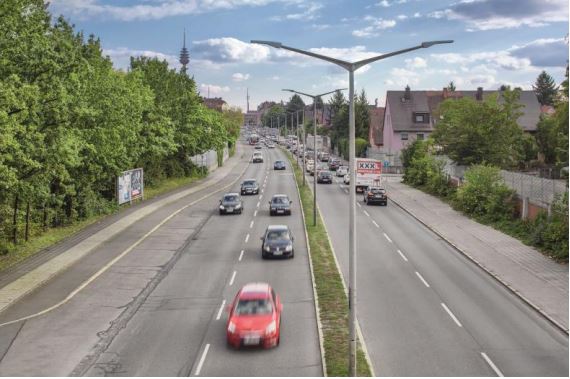Nuremberg is a true pioneer in efficient urban lighting. Innovative R2L2 LED street lanterns from Thorn play a major role here, fulfilling a range of different lighting tasks with tailored illumination levels and task-specific light distributions.
“Saving energy is the finest form of alternative energy. The best kilowatt hour is the kilowatt hour that is saved.” This is the motto of Nuremberg – and a motto that is impressively confirmed by a new street lighting concept in the German city. Even though the network of illuminated streets and roads has expanded from 1160 kilometres to 1204 kilometres over the last 20 years, energy consumption in 2016 actually declined from 22.8 million kWh (kilowatt hours) to 15.3 million kWh. A further reduction to little more than 15 million kWh is expected in 2017. This impressive change has been in part achieved by successively renewing approximately 1500 luminaires each year, starting with those that have the longest operating periods. These new lighting solutions have improved energy efficiency and replaced out-dated fittings, representing a real technological step forward. This progress is perfectly illustrated by the contemporary R2L2 LED street lanterns from Thorn Lighting, which first started to complement the Nuremburg cityscape in 2014.
 |
|
(Image: Thorn Lighting) |
A carefully considered approach
The public tender for the LED street lighting included a mixture of technical parameters and design requirements. The costs associated with assembly and maintenance were also key considerations. The R2L2 LED street lantern from Thorn fulfilled all the necessary requirements and represented the most cost-effective solution. As Norbert Hirschmann points out, “any difference in price was therefore no major issue."
Sleek, modern and timeless
A core feature of the R2L2 street lantern is precisely calculated lens technology. Individual lens clusters can be combined in the die-cast aluminium housing to create various luminaire sizes and light outputs of up to 30,000 lumens. In this way, both the luminous flux and the light distribution can be specified to suit the particular lighting task. The twelve different optics provide a carefully defined distribution without any stray light, helping to fulfil the varied lighting requirements of any public space: from wet roads to narrow, wide and extra-wide routes such as motorways; from footpaths and bike lanes to pedestrian crossings.
 |
|
(Image: Thorn Lighting) |
Yet a series of other features further add to the appeal of this street luminaire, which has been developed around a central concept of durability. The integration of high-performance R-PEC LED optics into the third generation of the R2L2 range has enabled the total number of components to be reduced, simultaneously lowering the likelihood of technical failure and improving serviceability. Ease of maintenance is further enhanced by the water-resistant and dust-repellent surface of the luminaire head, which performs the additional task of effectively dissipating heat and thereby extending the operating life of the LEDs.
Experience in practice
After nearly three years of operation, the overall results have been extremely positive. The product design and high-quality look continue to impress, while the various combinations of LEDs, lens technology and control gear have more than matched initial expectations. The installation has certainly made a good impression on Norbert Hirschmann: “We have only had issues with 15 of the 1800 R2L2 street lanterns. That is a very good ratio.” Equally pleasing is the fact that these Thorn luminaires have delivered annual savings of 800,000 kWh when compared to the original highpressure sodium vapour lamps.
 |
|
(Image: Thorn Lighting) |











